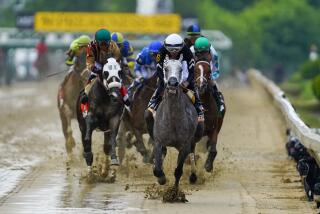Price of Yearlings Plummets at Keeneland : After Years of Soaring Prices, the Market in Race Horses Corrects Itself
- Share via
WASHINGTON — After a decade of growth and glamour, in which thoroughbreds came to be viewed as a solid investment on a par with gold and real estate, the horse-breeding industry’s bubble finally burst last week.
Experts had seen it coming for a long time, yet even the most pessimistic of them could not have imagined the results of the Keeneland Yearling Sales, the preeminent auction in the world and bellwether for the whole horse business. The average price of yearlings plummeted a staggering 24%--from $537,384 to $408,160. All but a lucky few of the sellers took a financial beating.
What happened in the upper echelon of the industry is also happening at all other levels of the market as well. At the recent Fasig-Tipton Kentucky sale, which deals with less regal pedigree than Keeneland, the average price dropped 10% from last year.
This decline in prices will cause much speculation and debate within the horse industry, but there is really little mystery about what has happened. The thoroughbred breeding business has gone through a speculative mania, resembling similar booms in stock and commodities. It was fueled by a euphoric sense that prices would keep going up, up, up forever, and it ended with a simple return to reality.
“Basically, this is still a marketplace which reacts like a marketplace,” said Bill Oppenheim, editor of the industry newsletter Racing Update. “What happened at Keeneland is pretty simple supply-and-demand logic.”
The boom began in the mid-1970s when British bookmaker Robert Sangster recognized that the prevailing prices for top-quality thoroughbreds were unrealistically low. He started buying the best pedigrees aggressively, and when he got some competition in the auction ring from the Maktoum brothers of Dubai, prices for horses soared to astronomical levels. Million-dollar yearlings, once unimaginable, became commonplace.
The demand of a few rich buyers for horses triggered a virtual stampede of people seeking to offer the supply. More and more horse owners sent their yearlings to sales; the number of horses sold at public auction more than doubled from 1974 to 1984. Good racehorses were retired hastily so they could make big money as stallions. To the investment community, the breeding business looked so attractive that scores of partnerships sprang up to cash in on the boom and the tax advantages of horse ownership.
The costs of breeding horses soared. Good mares sold for millions. Stud fees were staggering; mating a mare with the world’s top stallion, Northern Dancer, could cost as much as $700,000. But breeders were willing to pay as long as the prices for top yearlings kept spiraling, which they did until last year.
The market reached the ultimate in madness when Sangster and partners paid $13.1 million for a yearling last summer. Considering that the colt might be syndicated for $40 million at the most, Sangster was taking 2-to-1 odds that this animal who had not yet seen a race track would grow up to be the best race horse in the world.
By last year, breeders who were selling horses at the middle level of the market were losing money. They had paid high stud fees only to find that there were too many sellers and not enough buyers. And this week the same thing happened at Keeneland.
Sangster became a bit less active in buying horses; he already has hundreds of them and is breeding many of his own. He and the Arabs were less inclined to wage battles of bankrolls and egos. In fact, after Sangster bought a Northern Dancer colt for $3.6 million on Monday, he indicated that he and Sheik Mohammed Maktoum might wind up partners.
American money wasn’t as prominent at Keeneland as it has been in recent years. Ted Bassett, president of the Keeneland Assn., said, “The depression in the oil and gas business has hurt some. A number of domestic buyers from Texas, Oklahoma and Louisiana aren’t here this year.”
The buyers were not willing to pay astronomical prices--only two horses were sold for more than $2 million at Keeneland, compared with eight the year before. A shocking number of horses--47 in all--failed to bring $100,000.
The middle range of the sale was actually rather strong. Under other circumstances, the final figures at Keeneland would have been quite respectable. “People can make good money selling horses for $400,000--as long as they haven’t paid $300,000 for the stud fee,” Oppenheim pointed out.
But the sellers of yearlings this year had been paying stud fees in 1984, when prices hit their all-time high. At the Fasig-Tipton Sale, Oppenheim calculated, the total sales prices of the yearlings was $21 million, and their stud fees had cost $15 million. Since breeders also have to pay for the mares and for the raising of the horses, Oppenheim concluded, “Nobody made any money.”
The most immediate consequence of the disastrous prices in Kentucky will be a sharp drop in almost all stud fees. More people will be inclined to send horses to the track instead of the sales ring. Breeding syndicates formed on Wall Street will disappear. And the whole mentality of the horse market will change. As Jim Williams, Keeneland’s director of publicity put it, “Nobody is pressing the panic button, but there is a sense that we’re moving back to reality.”
When the last horse was led out of the Keeneland ring on Tuesday, an era had ended when breeders could dream that prices would keep rising forever. They had learned what they should have known all along: In the racing game there are no sure things.
More to Read
Go beyond the scoreboard
Get the latest on L.A.'s teams in the daily Sports Report newsletter.
You may occasionally receive promotional content from the Los Angeles Times.










